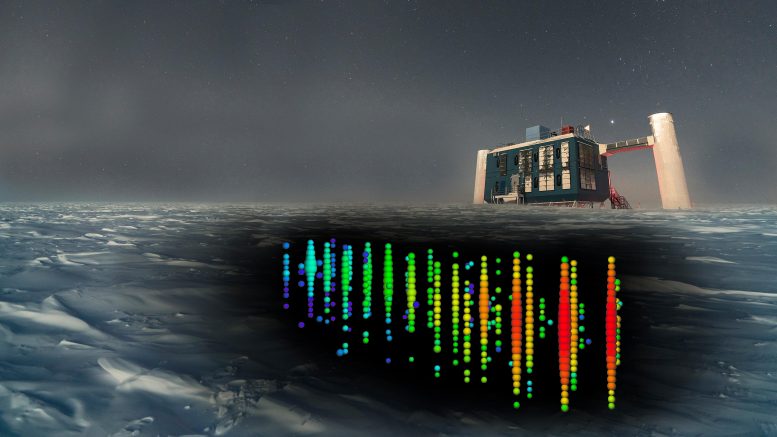
A view of the IceCube Neutrino Observatory, which is buried at depths between 1.5 and 2.5 kilometers below the Antarctic ice, at the South Pole. The only visible equipment above the surface is the IceCube Lab, which hosts the computers that collect data from the over 5,000 light sensors in the ice. Credit: IceCube Collaboration/NSF
University of Copenhagen team contributes to an Antarctic large-scale experiment striving to find out if gravity also exists at the quantum level; An extraordinary particle able to travel undisturbed through space seems to hold the answer.
Several thousand sensors distributed over a square kilometer near the South Pole are tasked with answering one of the large outstanding questions in physics: does quantum gravity exist? The sensors monitor neutrinos – particles with no electrical charge and almost without mass – arriving at the Earth from outer space. A team from the Niels Bohr Institute (NBI), University of Copenhagen, has contributed to developing the method that exploits neutrino data to reveal if quantum gravity exists.
“If as we believe, quantum gravity does indeed exist, this will contribute to unite the current two worlds in physics. Today, classical physics describes the phenomena in our normal surroundings such as gravity, while the atomic world can only be described using quantum mechanics. The unification of quantum theory and gravitation remains one of the most outstanding challenges in fundamental physics. It would be very satisfying if we could contribute to that end,” says Tom Stuttard, Assistant Professor at NBI.
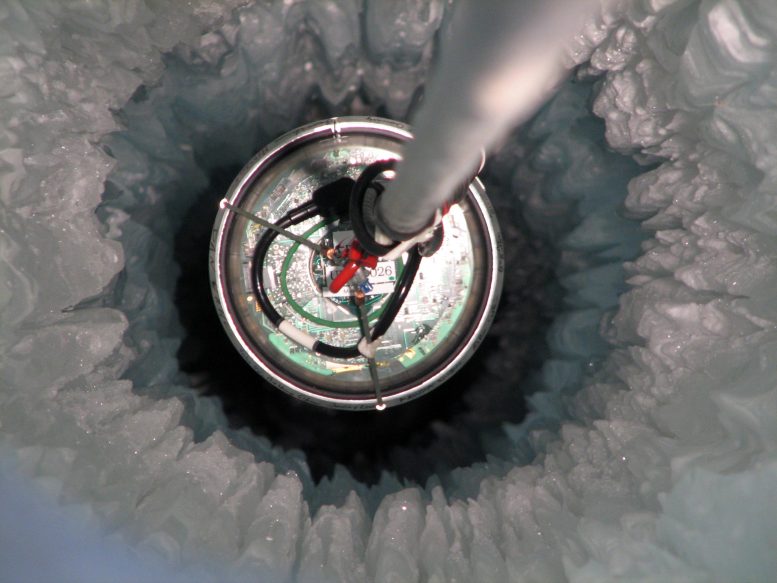
Finally the DOM descends into the array where it can start taking data. Credit: Mark Krasberg, IceCube/NSF
Tom Stuttard is co-author of a scientific article published today by the prestigious journal Nature Physics. The article presents results from a large study by the NBI team and American colleagues. More than 300,000 neutrinos have been studied. However, these are not neutrinos of the most interesting type originating from sources in deep space. The neutrinos in this study were created in the Earth’s atmosphere, as high-energy particles from space collided with Nitrogen or other molecules.
“Looking at neutrinos originating from the Earth’s atmosphere has the practical advantage that they are by far more common than their siblings from outer space. We needed data from many neutrinos to validate our methodology. This has been accomplished now. Thus, we are ready to enter the next phase in which we will study neutrinos from deep space,” says Tom Stuttard.
Traveling Undisturbed Through the Earth
The IceCube Neutrino Observatory is situated next to the Amundsen-Scott South Pole Station in Antarctica. In contrast to most other astronomy and astrophysics facilities, IceCube works the best for observing space at the opposite side of the Earth, meaning the Northern hemisphere. This is because while the neutrino is perfectly capable of penetrating our planet – and even its hot, dense core – other particles will be stopped, and the signal is thus much cleaner for neutrinos coming from the Northern hemisphere.
The IceCube facility is operated by the University of Wisconsin-Madison, USA. More than 300 scientists from countries around the world are engaged in the IceCube collaboration. University of Copenhagen is one of more than 50 universities having an IceCube center for neutrino studies.
Since the neutrino has no electrical charge and is nearly massless, it is undisturbed by electromagnetic and strong nuclear forces, allowing it to travel billions of lightyears through the Universe in its original state.
The key question is whether the properties of the neutrino are in fact completely unchanged as it travels over large distances or if tiny changes are notable after all.
“If the neutrino undergoes the subtle changes that we suspect, this would be the first strong evidence of quantum gravity,” says Tom Stuttard.
The Neutrino Comes in Three Flavors
To understand which changes in neutrino properties the team is looking for, some background information is called for. While we refer to it as a particle, what we observe as a neutrino is really three particles produced together, known in quantum mechanics as superposition. The neutrino can have three fundamental configurations — flavors as they are termed by the physicists — which are electron, muon, and tau. Which of these configurations we observe changes as the neutrino travels, a truly strange phenomenon known as neutrino oscillations. This quantum behavior is maintained over thousands of kilometers or more, which is referred to as quantum coherence.
“In most experiments, the coherence is soon broken. But this is not believed to be caused by quantum gravity. It is just very difficult to create perfect conditions in a lab. You want perfect vacuum, but somehow a few molecules manage to sneak in etc. In contrast, neutrinos are special in that they are simply not affected by matter around them, so we know that if coherence is broken it will not be due to shortcomings in the man-made experimental setup,” Tom Stuttard explains.
Many Colleagues Were Skeptical
Asked whether the results of the study published in Nature Physics were as expected, the researcher replies:
“We find ourselves in a rare category of science projects, namely experiments for which no established theoretical framework exists. Thus, we just did not know what to expect. However, we knew that we could search for some of the general properties we might expect a quantum theory of gravity to have.”
“Whilst we did have hopes of seeing changes related to quantum gravity, the fact that we didn’t see them does not exclude at all that they are real. When an atmospheric neutrino is detected at the Antarctic facility, it will typically have traveled through the Earth. Meaning approximately 12,700 km — a very short distance compared to neutrinos originating in the distant Universe. Apparently, a much longer distance is needed for quantum gravity to make an impact, if it exists,” says Tom Stuttard, noting that the top goal of the study was to establish the methodology:
“For years, many physicists doubted whether experiments could ever hope to test quantum gravity. Our analysis shows that it is indeed possible, and with future measurements with astrophysical neutrinos, as well as more precise detectors being built in the coming decade, we hope to finally answer this fundamental question.”
Reference: “Search for decoherence from quantum gravity with atmospheric neutrinos” by The IceCube Collaboration, 26 March 2024, Nature Physics.
DOI: 10.1038/s41567-024-02436-w

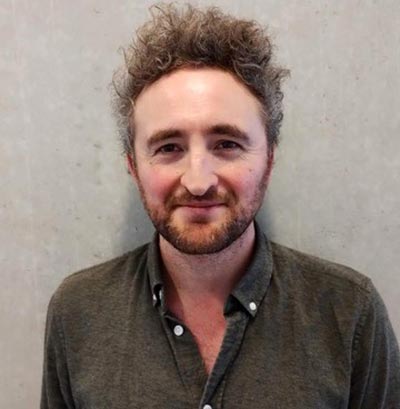
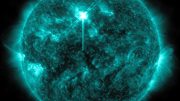

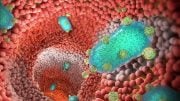
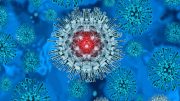
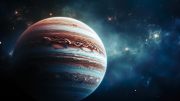

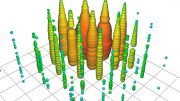
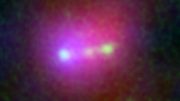
Please ask the researcher to think,
1. If humans can only understand the world through vision, how should we describe this world?
2. If humans can only understand the world through hearing, how should we describe this world?
3. If humans can only understand the world through their senses, how should we describe this world?
4. Is the world understood through vision, hearing, and sensation necessarily the same?
5. If there is a difference in the world understood through vision, hearing, and sensation, has the world changed, or have we humans changed?
6. Is the world understood through vision, hearing, and sensation necessarily its entirety?
7. What is the basis for the formation of mirror images between two sets of Cobalt-60 by reverse rotation?
8. Why can pseudoscience be so rampant?
9. Is Physics Review Letters (PRL), Nature, Science, etc. a popular science publication or a pseudoscience cancer?
10. Is scientific experimentation omnipotent?
11. What is the foundation on which the Nobel Prize can promote scientific progress?
12. Is the Nobel Prize always correct?
and so on.
Science and pseudoscience are not determined by a publication, an organization or a person, nor by you or me, but by mathematics the final say. Physical models must be based on mathematics or mathematical models in order to be scientific, convincing, and in accordance with natural laws.
The origin of geometry lies in the concerns of everyday life. The branch of geometry (mathematics) known as topology has become a cornerstone of modern physics. Topological vortex and antivortex are two bidirectional coupled continuous chaotic systems. They exhibit parity conservation, charge conjugation, and time reversal symmetry. The synchronization effect is extremely important in their interactions. The synchronization effect of the superposition, deflection, and twisting of multiple or countless topological vortices will make spacetime motion more complex. To understand this complex world, physics should respect the authenticity of topological vortex in low dimensional spacetime, rather than simply relying on a few formulas, numbers, or imagined particles.
Spin is a natural property of topological vortices. Spin is synchronized with energy, spin is synchronized with gravitation, spin is synchronized with time, spin is synchronized with evolution. The perpetually swirling topological vortices defy traditional physics’ expectations. One physical properties of topological vortices is them to spontaneously begin to change periodically in time, even though the system does not experience corresponding periodic interference. Therefore, in the interaction of topological vortices, time is both absolute and relative,and physics often requires treating space and time at the same level.
Low-dimensional spacetime matter is the foundation of high-dimensional spacetime matter. Low-dimensional spacetime matter (such as topological vortex) can form new material structures and derive more complex physical properties via interactions and self-organization. It is extremely wrong and irresponsible to imagine low dimensional spacetime matter using high-dimensional spacetime matter,such as a cat in quantum mechanics.
Science must follow mathematical rules. For example, the Standard Model (SM) is considered to be one of the most significant achievements of physics in the 20th century. However, the magnetic moment of μ particle is larger than expected, revealed by a g-2 experiment at Fermilab, suggests that the established theory (such as SM) of fundamental particles is incomplete. Furthermore, the SM omitting gravitation, it not involved the time problem and when the particle movement starts. Mathematics is the foundation of science. Physics must respect the scientific nature of mathematics and mathematical models. The SM must be based on mathematical models in order to be scientific, convincing, and in line with natural laws.
I hope researchers are not fooled by the pseudoscientific theories of the Physical Review Letters (PRL), and hope more people dare to stand up and fight against rampant pseudoscience.
The so-called academic journals (such as Physical Review Letters, Nature, Science, etc.) firmly believe that two high-dimensional spacetime objects (such as two sets of cobalt-60) rotating in opposite directions can be transformed into two objects that mirror each other, is a typical case of pseudoscience rampant.
If researchers are really interested in Science and Physics, you can browse https://zhuanlan.zhihu.com/p/643404671 and https://zhuanlan.zhihu.com/p/595280873.
The Physical Review Letters (PRL) is the most evil, ugly, and dirty publication in the history of science. Nature and Science have been influenced by Physical Review Letters (PRL) and are even more notorious. The behavior of these pseudo-academic publications has seriously hindered the progress and development of human society in science and technology.
I am well aware that my relentless repetition can make some people unhappy, but in the fight against rampant pseudoscience, that’s all I can do.